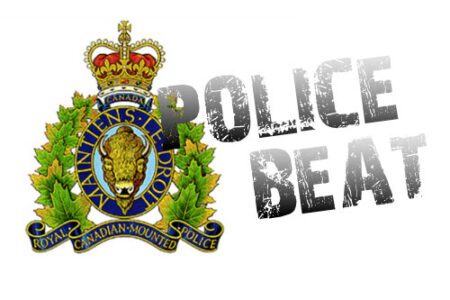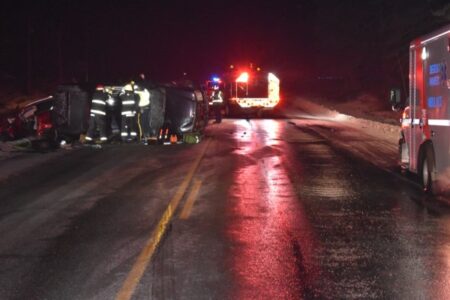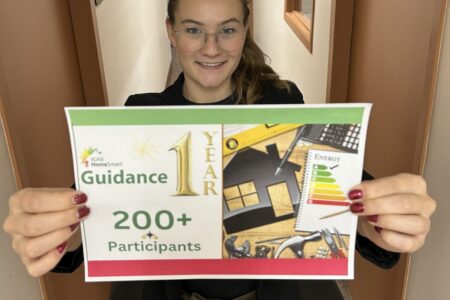National Historic Site designation for Rossland Miners Union Hall
On March 6, 2020, the Lily May Room at the Rossland Miners Union Hall held a festive gathering of Rossland notables, Parks Canada personnel, our local Member of Parliament and a representative of our local MLA; all were celebrating the designation of Rossland’s Miners Union Hall as a Federal Historic Site.
Speakers included Amy Krause and Dwight Bourdin, both of Parks Canada, Cyra Yunkws on behalf of MLA Katrine Conroy, MP Dick Cannings, Rossland Heritage Commission Chair Michelle Fairbanks, and Rossland Mayor Kathy Moore. J.L. Crowe student Brynn Streadwick lead the gathering in singing “O Canada.”
In her speech, Mayor Kathy Moore credited those who most recently helped restore the Miners Union Hall once again. She explained,
“The Miners Hall wasn’t always as lovingly maintained as it is today. It has been restored more than once, as the Heritage Commission will tell you. The Rossland Council for Arts and Culture along with the City, and individual citizens, worked to create a plan for the building and then set about making it a reality. Major funding was received from the Federal and Provincial governments, as well the City. Generous support from CBT, Teck Metals, Cultural Spaces and other funders such as the local Rotary club and individuals made this building what it is today. The Miners Hall is an iconic building that celebrates our mining and labour rights history and serves as a vibrant community centre today. All of these contributions are greatly appreciated.”
Michelle Fairbanks, Chair of the Rossland Heritage Commission, read a history of the building that had been researched and written by Joanne Drystek of the Heritage Commission and Sarah Taekema of the Rossland Museum.
Mayor Moore and Dwight Bourdin of Parks Canada unveiled a plaque that will be installed outside the Miners Hall.
When the ceremony was complete, Moore called for attention and presented retired Heritage Commission chair Jackie Drysdale, who was recently honoured by Heritage BC with a Lifetime Achievement Award, with a special plaque to honour her role in the community, including promoting Rossland’s history. Moore pointed out that Drysdale was Rossland’s first female mayor.

(Left to right: MP Dick Cannings, Jackie Drysdale, and Mayor Kathy Moore. Photo by Dave Cornelius.)
For local residents who have been vaguely aware of the Miners Hall history and its union beginnings, but don’t know many of the details, it’s a fascinating story – and explains how influential the Rossland miners were on both provincial and federal legislation regarding labour relations and the recognition and protection of unions, so we’re publishing the full text of it below, as written by Joanne Drystek and Sarah Taekema:
Rossland Miners Union Hall History
The significance of the Rossland Miners Union Hall extends far beyond this building on the western end of Columbia Avenue. In the 1890s, the discovery of high purity gold-rich veins in Red Mountain prompted thousands of miners and prospectors from all over the world to flock to its south slope, quickly turning it into a bustling mining camp. However, Rossland’s hard rock gold mines were challenging to develop and required a significant capital investment to operate. To accomplish this, many American companies bought up the small, independent mine sites in BC, which in turn attracted American miners in droves. These miners were usually transients, moving from bonanza to bonanza, typically working underground for 10 to 12 hours a day. The result was miners having little control over their working conditions, which were determined by absentee owners and remote investors. The answer was organized labour unions. In 1895, Rossland was granted a charter from the Western Federation of Miners (WFM), an American union that grew out of Butte, Montana.
Rossland’s branch, Local No. 38 became the first international branch for the WFM. Notably, it was the first Canadian branch of the union and the first union for metalliferous mines in British Columbia.
Believing in their commitment and the permanence of the union, the members of Local No. 38 donated a day’s wage to build themselves a hall and $6,537.75 was collected. This Miners Union Hall was opened on July 16, 1898 to much fanfare. Miners and merchants closed up shop to join in the fun of a parade, rock drilling contest, tug-of-war and horse-racing on Columbia Avenue. The Miners Hall was declared to be, by the local paper, “the most substantial building of its character in the Kootenays”.
The architect for the Miners Union Hall was E. J. Weston. The hall itself is a three-storey building of high Victorian architecture. The structure of the hall is very unusual for a building, as the heavy timber support beams are reminiscent of those used in mine tunnels. This sturdy building withstood not only heavy snowfall, but also a sixteen man patrol team that conducted drill practices in the attic before the Drill Hall was built in 1904, and a cyclone in 1913.
Mr. Weston designed the interior of the building so it could be used for many purposes. On the main floor there is a raised, raked stage large enough for group perfomances, and a spacious main hall suitable for large gatherings and social events. There was an interior balcony built above the front entrance way that was accessed from the main floor which provided more space. On the lower level, there was a smaller meeting area (the Union’s Lodge Room) with a low stage and also family quarters for the Union Secretary and his family. The boilers for heating were located below the lower level, in the half basement.
When Local No. 38 started, unions had no legal protection or recognition. In the battle to obtain both, Rossland became a rallying point for the working man. Not as apolitical as their eastern counterparts or as violent as their American peers, British Columbian miners succeeded in having their proposals passed into law by the government. The peaceful approach of the local miners and the understanding of good public relations by union leaders made discussions with government possible. The legislative route gave them legal standing with its accompanying protections and it gave the union legitimacy and recognition, which it had not had before the Rossland miners took this approach.
In February, 1899, through the support of Rossland’s Member of the Legislative Assembly, James M. Martin, and Nelson’s J. F. Hume, Minister of Mines, the Western Federation of Miners in British Columbia achieved a legislative ruling: the Eight Hour Work Day statute for all metalliferous mines in the province passed into law. 6 With more mining camps unionizing to consolidate the legal victory, (eleven of them in nine months) the goal of collective bargaining was suddenly viable. The Act was quickly adopted by other trades.
But, this did not solve all the problems – there was still agitation and unrest. R. C. Clute, Q.C., a prominent Toronto lawyer and former chairman of the Board of Arbitration for Ontario’s Trades Dispute Act, was sent by the Canadian government to address the unrest in the mining camps. He held hearings in Rossland and the surrounding areas in December 1899. He reported to Ottawa that compulsory arbitration would be less effective than conciliatory measures. It took Clute another trip and the continued firmness of the miners before the last holdouts, the Rossland mine owners, reached a limited agreement. His reports led to the federal Conciliation Act of 1900. That legislation helped create the Department of Labour and the Canadian system of industrial relations.
In July 1901, 900 to 1000 Rossland miners went on strike. The crucial issues for the Rossland Miners Union were raising muckers wages from $2.50 a day to the regional standard of $3.00 a day, ending discrimination against union members, and solidarity for the Northport smelter workers. The strike was long and brutal; the financial burden of this strike was a hardship to all involved and the need for settlement was clear. In January 1902, a resolution was reached. Although the mucker wage remained unchanged, the strike resulted in the introduction of labour legislation in BC, particularly the Trade Union Protection Act (1902) which protected unions from liability for employers’ financial losses incurred during a strike.
Smith Curtis, the succeeding member MLA from Rossland, introduced the Workmen’s Compensation Act of 1900 to the British Columbia legislature. That Act was the forerunner to the British Columbia Workmen’s Compensation Act of 1917.
In 1907, based on the Royal Commission of 1903’s findings and Clute’s early reports and successes, then Deputy Minister of Labour William Lyon Mackenzie King formulated the Industrial Disputes Investigation Act. With its principle of compulsory investigation, it became the basis of the Canadian system of collective bargaining.
The WFM’s strong unionized voice continued to reach Victoria and Ottawa in demand of other statutes and regulations. Many of these original rulings evolved into Provincial and Canadian laws on labour, employment, safety and compensation.The WMF was one of the most influential and successful labour unions in British Columbia’s history.
Purposed for union meetings and community events, the Miners’ Union Hall was a key institution in Rossland. But, after the mines closed in 1929, the population declined and buildings, including this one, fell into disrepair. In 1978 the Rossland Heritage Society initiated the huge task of attempting to restore the Miners Union Hall to its original condition and use as a community focal point for social activities. Derelict was the best descriptive word of the Hall at this time. Together the Society, Local 480 and the City developed a plan and with a great deal of financial support from the senior levels of Government the restoration work began. The most costly part of the project dealt with the foundation and the open surface waters flowing between its footings. In September of 1983, a beautifully refurbished and restored Miners’ Union Hall reopened.
Over the next thirty-three years, the Miners’ Union Hall continued to be a hub for community events. However, as time passed it became apparent that major restoration was again required. In November, 2015, Fairbank Architects and Thomas Loh Architect provided a design brief for the Miners Hall renovation and restoration. The design plan encompassed building exterior maintenance and upgrade, attic floor reclamation , façade restoration and entry plaza/ forecourt remodel. The renovation was completed in 2017 and resulted in a fully restored exterior as well as additional usable space in the attic.
The Rossland Miners’ Union Hall exemplifies and celebrates the mining origins of the city. Today, we recognize the Rossland Miners’ Union Hall as one of BC’s earliest surviving union halls and one of the few still existing wooden buildings of this era, stature and use in the province. It is valued as a touchstone to the mining heyday of the 1890’s, which initiated the development of infrastructure, transportation and permanent settlements in the Kootenay-Boundary Region of B.C.























Comments